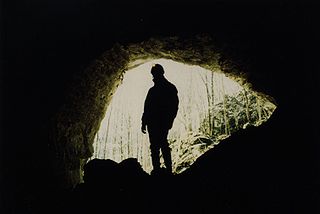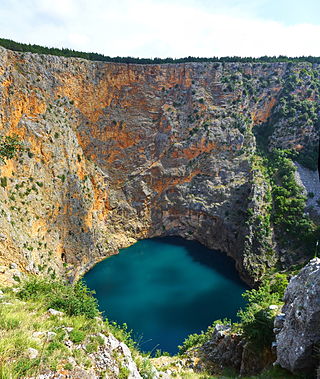Related Research Articles

Karst is a topography formed from the dissolution of soluble carbonate rocks such as limestone, dolomite, and gypsum. It is characterized by features like poljes above and drainage systems with sinkholes and caves underground. More weathering-resistant rocks, such as quartzite, can also occur, given the right conditions.

Mammoth Cave National Park is a national park in south-central Kentucky, US. It encompasses portions of Mammoth Cave, the longest known cave system in the world. The park's 52,830 acres (21,380 ha) are located primarily in Edmonson County, with small areas extending eastward into Hart and Barren counties. The Green River runs through the park, with a tributary called the Nolin River feeding into the Green just inside the park.

Speleology is the scientific study of caves and other karst features, as well as their composition, structure, physical properties, history, ecology, and the processes by which they form (speleogenesis) and change over time (speleomorphology). The term speleology is also sometimes applied to the recreational activity of exploring caves, but this is more properly known as caving, potholing, or spelunking. Speleology and caving are often connected, as the physical skills required for in situ study are the same.

A sinkhole is a depression or hole in the ground caused by some form of collapse of the surface layer. The term is sometimes used to refer to doline, enclosed depressions that are also known as shakeholes, and to openings where surface water enters into underground passages known as ponor, swallow hole or swallet. A cenote is a type of sinkhole that exposes groundwater underneath. Sink and stream sink are more general terms for sites that drain surface water, possibly by infiltration into sediment or crumbled rock.

The National Speleological Society (NSS) is an organization formed in 1941 to advance the exploration, conservation, study, and understanding of caves in the United States. Originally headquartered in Washington D.C., its current offices are in Huntsville, Alabama. The organization engages in the research and scientific study, restoration, exploration, and protection of caves. It has more than 10,000 members in more than 250 grottos.

At 150.4 miles (242.0 km), Lechuguilla Cave is the eighth-longest explored cave in the world and the second deepest in the continental United States. It is most famous for its unusual geology, rare formations, and pristine condition.
The Cave Research Foundation (CRF) is an American private, non-profit group dedicated to the exploration, research, and conservation of caves. The group arose in the early 1950s from the exploration efforts at Floyd Collins Crystal Cave, now within Mammoth Cave National Park. Its stated goals were: to promote exploration and documentation of caves and karst areas, initiate and support cave and karst research, aid in cave conservation and protection, and to assist with the interpretation of caves and karst to the public.

The Leon Sinks Geological Area is located on the Woodville Karst Plain in southern and southwestern Leon County, Florida, United States. It is a mature karstic area on the Upper Floridan Aquifer. It is one of the most extensive underwater cave systems in the world and connects to Wakulla Springs.

Dos Ojos is part of a flooded cave system located north of Tulum, on the Caribbean coast of the Yucatán Peninsula, in the state of Quintana Roo, Mexico. The exploration of Dos Ojos began in 1987 and still continues. The surveyed extent of the cave system is 82 kilometers (51 mi) and there are 28 known sinkhole entrances, which are locally called cenotes. In January 2018, a connection was found between Sistema Dos Ojos and Sistema Sac Actun. The smaller Dos Ojos became a part of Sac Actun, making the Sistema Sac Actun the longest known underwater cave system in the world.
There are a number of caving organizations throughout the world.
Sistema Sac Actun is an underwater cave system situated along the Caribbean coast of the Yucatán Peninsula with passages to the north and west of the city of Tulum. Discovery of a connection to Sistema Dos Ojos in 2018 made it the longest known underwater cave system. As of January 2023, it is the second longest underwater cave system in the world, only surpassed by Sistema Ox Bel Ha.

Agnes Milowka was an Australian technical diver, underwater photographer, author, maritime archaeologist and cave explorer. She gained international recognition for penetrating deeper than previous explorers into cave systems across Australia and Florida, and as a public speaker and author on the subjects of diving and maritime archaeology. She died aged 29 while diving in a confined space.

The Wittenberg University Speleological Society (WUSS) is a student-run grotto of the National Speleological Society (NSS) created in 1980, dedicated to the advancement of speleology. WUSS has more than 500 members, current and past students, faculty and staff of Wittenberg University, as well as community members dedicated to the scientific study, exploration, and preservation of caves and karst environments. The organization is based out of Wittenberg University in Springfield, Ohio.

The Butler Cave Conservation Society (BCCS) is a 501(c)(3) non-profit Virginia corporation dedicated to the conservation, exploration, survey, preservation, and scientific study of the caves and karst in and around Burnsville Cove, Virginia.

Tears of the Turtle Cave is located in the Bob Marshall Wilderness in western Montana and is currently the deepest known limestone cave in the United States since passing New Mexico's Lechuguilla cave in 2014. As of August 2022, the cave is known to be 2,052 feet (625 m) deep and 1.488 miles (2,395 m) long. The cave consists mostly of narrow fissure passages passing over approximately 50 short rope drops. With a mean temperature of 37 °F (3 °C) it is muddy and poorly decorated.

Matthew D. Covington is an American speleologist, most known for his work in hydrogeology and geomorphology, especially in the field of mathematical modeling of karst systems, as well as by his contribution to Cueva Chevé project in Mexico, since 1999.
Annette Summers Engel is an American earth scientist who is Donald and Florence Jones Professor of Aqueous Geochemistry at the University of Tennessee. Her research considers how microbes interact with rocks and minerals. She was elected Fellow of the American Association for the Advancement of Science in 2019.
Diana E. Northup is an American microbiologist, speleologist, ecologist, Visiting Professor of Biology, and Professor Emerita of Library Sciences with the University of New Mexico. Her research focuses on the microbial ecology of caves around the world. Dr. Northup is a Fellow of the National Speleological Society and the Cave Research Foundation. She wrote the Wiley textbook Microbial Ecology. She was awarded the National Speleological Society Science Prize in 2013.
References
- ↑ Congress, The Library of. "LC Linked Data Service: Authorities and Vocabularies (Library of Congress)". id.loc.gov. Retrieved 2021-03-18.
- ↑ "LC|no2016141496". viaf.org. Retrieved 2021-03-18.
- ↑ "Faculty and Staff in the Department of Geography and Geology". Western Kentucky University. Retrieved 2021-03-17.
- ↑ "ONLINE STORE: HISTORY". National Speleological Society. Retrieved 2021-03-16.
- ↑ "Patricia Kambesis | Western Kentucky University - Academia.edu". wku.academia.edu. Retrieved 2021-03-17.
- 1 2 Patricia, Kambesis (April 2007). "The Importance of Cave Exploration to Scientific Research". Journal of Cave and Karst Studies. 69: 46 – via ResearchGate.
- 1 2 Kambesis, Patricia (2011). "Exploring for Solutions to the Water Challenges on the East Mountain Plateau in Yunnan Province" (PDF). Woodrow Wilson International Center for Scholars. China Environment Series. 11: 154.
- ↑ Kambesis, Patricia (2017). "Exploration of the Caves of Isla de Mona, Puerto Rico" (PDF). International Congress of Speleology. 2 (Proceedings of the 17th International Congress of Speleology, Sydney 2017): 44.
- ↑ Kambesis, Patricia (2017). "Origin of Enigmatic Caves of the Far Western United States" (PDF). International Congress of Speleology. 2: 45.
- 1 2 3 Kambesis, Patricia (2017). "Exploring the Mechanisms and Consequences of Cave Roof Collapses Using the National Corvette Museum Sinkhole Case Study" (PDF). International Congress of Speleology. 2: 310.
- ↑ Kambesis, Patricia (2015). "5. Morphometric analysis of cave patterns using fractal indices". Morphometric analysis of cave patterns using fractal indices. Geological Society of America Special Papers. Vol. 516. pp. 67–86. doi:10.1130/2016.2516(06). ISBN 978-0-8137-2516-1 . Retrieved 2021-03-23.
- 1 2 "NSS Fellows Awardees". caves.org. Retrieved 2021-03-17.
- 1 2 3 4 5 6 7 8 "FACULTY". wkuchnges. Retrieved 2021-03-16.
- 1 2 "Cave Survey and Cartography". wkukarstfieldstudies. Retrieved 2021-03-17.
- 1 2 3 4 5 "Patricia Kambesis". extraordinarywls.blogspot.com. Retrieved 2021-03-16.
- ↑ "Cartographic Salon". caves.org. Retrieved 2021-03-14.
- 1 2 3 4 5 6 7 8 9 10 Dasher, George (2008-01-03). "NSS CARTOGRAPHIC SALON" (PDF). National Speleological Society. Retrieved 2021-03-14.
- ↑ "Cart 2019 Winners". caves.org. Retrieved 2021-03-17.
- 1 2 "Cart 2013 Winners". caves.org. Retrieved 2021-03-17.
- ↑ "Cart 2011 Winners". caves.org. Retrieved 2021-03-17.
- ↑ "Cart 2010 Winners". caves.org. Retrieved 2021-03-17.
- 1 2 "Cart 2009 Winners". caves.org. Retrieved 2021-03-17.
- ↑ "WKU Geography & Geology Faculty, Staff & Students Participate in International Program". Media Relations. Retrieved 2021-03-17.
- ↑ Patricia, Kambesis (1999). Deep Secrets: The Discovers & Exploration of Lechuguilla Cave. Cave Books. ISBN 9780939748181.
- ↑ "WKU professors appear in sinkhole documentary, assist with educational exhibit". WKU News Blog. 2015-03-06. Retrieved 2021-03-17.
- 1 2 Kambesis, Patricia; Despain, Joel; Groves, Chris (February 15, 2013). The Making of a Connection: Exploration/Survey in Whigpistle Cave System. Mammoth Cave Research Symposia.
- ↑ "Geogram: The Annual Newsletter of the Department of Geography and Geology at Western Kentucky University" (PDF). Western Kentucky University: Department of Earth, Environmental, and Atmospheric Sciences. 2008. Retrieved 2021-03-16.
- ↑ "NSS International Exploration Grants". caves.org. Retrieved 2021-03-17.
- ↑ "CRF Officers". www.cave-research.org. Retrieved 2021-03-17.
- ↑ Campion, Ged; Harrison, Tony (August 2014). "China Caves" (PDF). Cave and Karst Science. 41 (2). Retrieved 2021-03-24– via British Cave Research Association.
- ↑ "WKU Geography & Geology Faculty, Staff & Students Participate in International Program". Media Relations. Retrieved 2021-03-16.
- ↑ Kambesis, Patricia (January 2018). "Caves and Karst of the Judas-Aguada Coastal Plain, Caguanes National Park, Sancti Spiritus, Cuba". Caves of Sancti Spiritus, Matanzas and Pinar del Rio, Cuba.
- ↑ Kambesis, Patricia; Despain, Joel; Groves, Chris (2013-02-15). "The Making of a Connection: Exploration/Survey in Whigpistle Cave System". Mammoth Cave Research Symposia.
- ↑ "Lechuguilla Cave, New Mexico, U.S.A | Patricia Kambesis - Academia.edu". www.academia.edu. Retrieved 2021-03-23.
- ↑ "NSS News" (PDF). NSS NEWS Archive. National Speleological Society. July 2009. p. 4. Retrieved 2021-03-23.